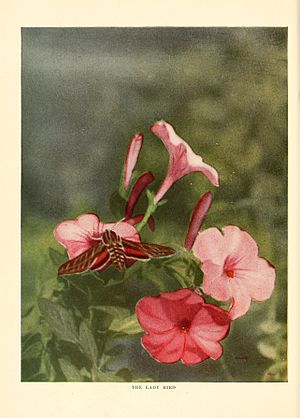Limberlost Swamp facts for kids
The Limberlost Swamp was a very large wetlands area in eastern Indiana, USA. It had many streams that flowed into the Wabash River. This swamp originally covered about 13,000 acres (53 square kilometers) in Adams and Jay counties. Some parts were called the Loblolly Marsh. This name came from local Native Americans, who used a word for the sulfur smell of the marsh gas.
The Limberlost wetlands were full of different plants and animals. They were very important for many local and migrating birds, insects, and other wildlife.
In the early 1900s, people drained the Limberlost Swamp to create farmland. This destroyed the rich natural home for many creatures. However, since 1997, parts of the swamp have been brought back to life. As of 2015, about 1,500 acres (6.1 square kilometers) had been restored. Many insects, birds, and other animals have returned to these restored areas. Different groups helped buy land for what is now called the Loblolly Marsh Nature Preserve. This preserve is now managed by the Indiana Department of Natural Resources.
Contents
How the Limberlost Swamp Got Its Name
Have you ever wondered how the Limberlost Swamp got its unique name? There are a couple of stories about it!
The Story of Limber Jim
One story comes from the "History of Jay County," published in 1864. It says that a man named James Miller was hunting near the swamp. He got lost and kept walking in circles. To find his way out, he decided to walk in a straight line, marking trees every few steps. His friends found him while he was doing this. James was a very flexible and agile man, so people called him 'Limber Jim.' After he got lost, the stream and the swamp became known as 'Limberlost.'
Another Tale of Limber's Loss
The Indiana State Museum tells a slightly different version. They say the swamp was named after 'Limber Jim' Corbus. He went hunting in the swamp and never came back. When people asked where Jim Corbus was, they would say, "Limber's lost!" This sad event gave the swamp its name.
The Limberlost Swamp in Books and Movies
The Limberlost Swamp became very famous because of an author named Gene Stratton-Porter.
Gene Stratton-Porter's Connection
Gene Stratton-Porter was born in Indiana. She lived near the Limberlost Swamp for many years in the early 1900s. She tried to stop the swamp from being destroyed, but she wasn't successful. The swamp became the setting for two of her popular novels: Freckles (published in 1904) and A Girl of the Limberlost (published in 1909). Her book The Harvester (1911) even mentions many of the plants found in the swamp at that time.
Stratton-Porter was also a talented artist and photographer. She took amazing close-up pictures of birds and moths in their natural homes. Several of her nature books, like Moths of the Limberlost (1912), show the wildlife of the swamp. Her homes in the area were like her science labs for her research. Today, you can visit them! They are preserved as the Limberlost Cabin in Geneva and the Cabin at Wildflower Woods in Rome City. The Indiana State Museum and Historic Sites manages these places, and they are open for people to visit.
Movies About the Limberlost
The Limberlost Swamp also inspired movies! Romance of the Limberlost is a movie from 1938. It was based on Gene Stratton-Porter's writings. The movie was directed by William Nigh and starred Jean Parker and Eric Linden. It takes place in Indiana's Limberlost region in 1905.


